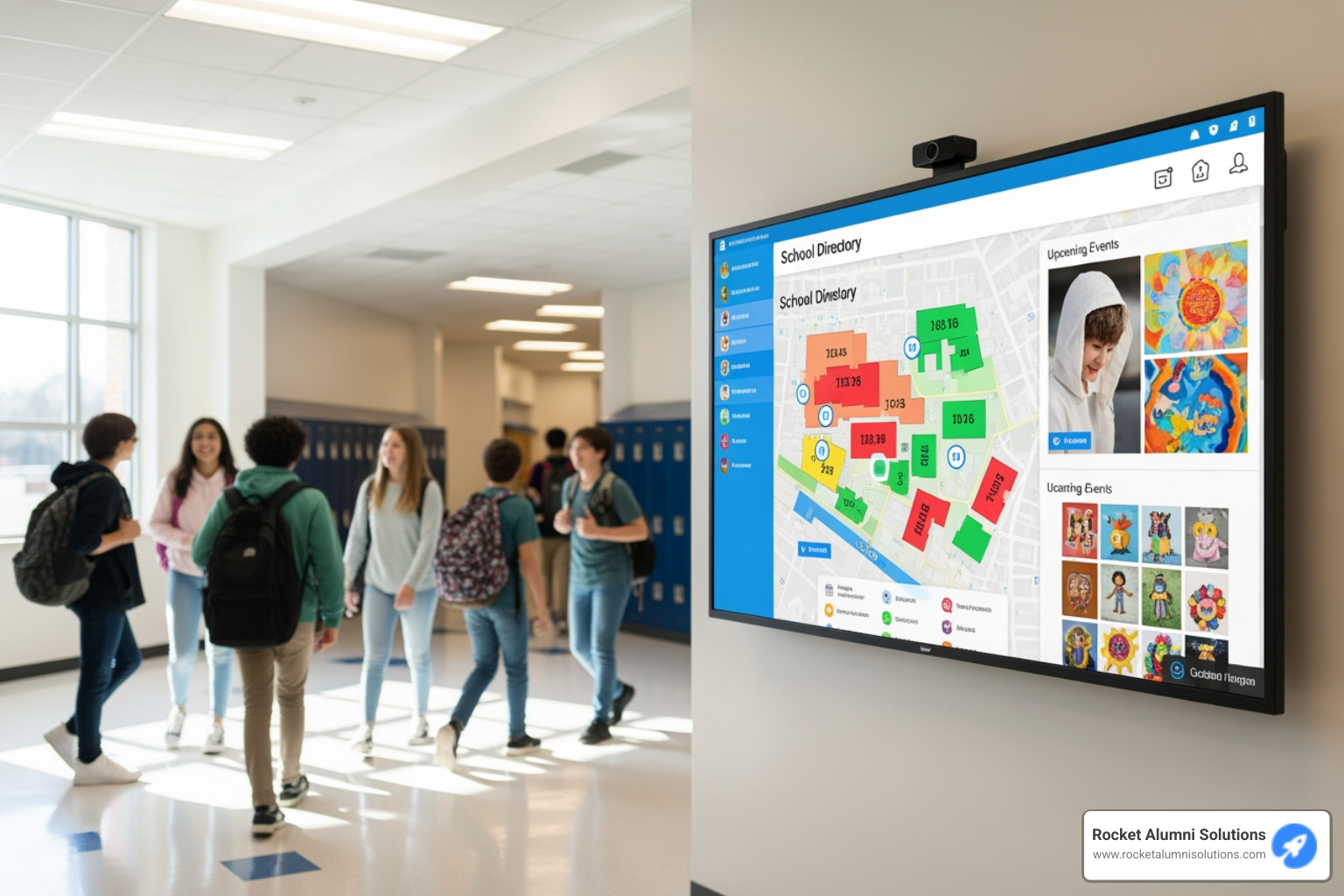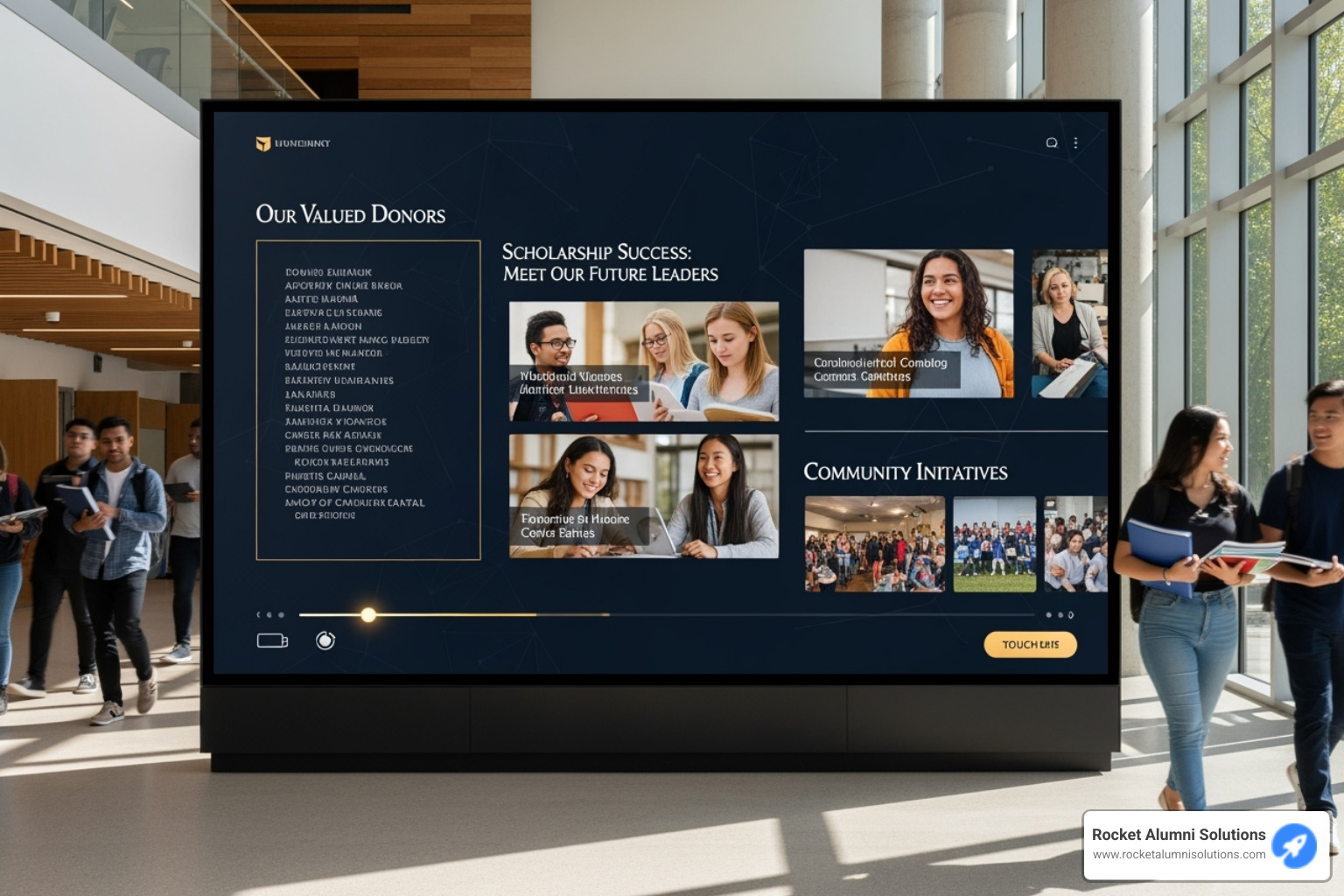Why Student Leadership Recognition Needs a Digital Change
Student Leadership Touchscreen systems are interactive digital displays that showcase student achievements, leadership positions, and accomplishments across all programs—athletics, academics, fine arts, community service, and more—using cloud-based software and commercial-grade touchscreen hardware.
Quick Answer: What You Need to Know
- What it is: An interactive kiosk that replaces static trophy cases and plaques with unlimited digital recognition capacity
- Key benefits: Equitable recognition across all programs, instant updates, improved engagement, space consolidation
- Capacity: Can showcase thousands of achievements that would require dozens of traditional trophy cases
- Cost: $8,000-$20,000 initial investment per display, comparable to or less than traditional systems long-term
- Impact: Students in schools with equitable digital recognition report 38% higher satisfaction with school culture
Traditional recognition methods create an uncomfortable truth: 73% of schools report inadequate display space for student achievements across all programs. When football trophies fill the main entrance case while debate champions, orchestra all-state selections, and robotics team victories go unrecognized due to space constraints, schools send unintended messages about which accomplishments truly matter.
The recognition gap goes beyond physical limitations. Students in programs receiving less visible recognition report 42% lower satisfaction with school culture around achievement celebration. Trophy cases can't be updated quickly. Plaques require months to produce. And when space runs out, schools face impossible choices about whose achievements to remove to make room for new ones.
Digital change is changing this equation. Interactive touchscreen displays eliminate space constraints entirely, allow instant updates, and create engaging experiences where students can explore achievements through multimedia—photos, videos, searchable profiles, and interactive timelines. A single 55-inch touchscreen can showcase the same content that would require hundreds of feet of wall space and dozens of traditional cases.
The shift isn't just about technology—it's about equity and engagement. Students in schools with equitable recognition systems across programs report 29% greater sense of belonging. When every form of excellence receives appropriate celebration, schools build cultures where all students feel valued.
As Chase McKee RAS, Founder & CEO of Rocket Alumni Solutions, I've seen how personalized recognition displays drive real results—our partner schools experienced over 25% increases in community engagement when we liftd every contributor's story through our Student Leadership Touchscreen software. By making achievement recognition interactive and equitable, schools transform how they celebrate student success and build lasting institutional culture.
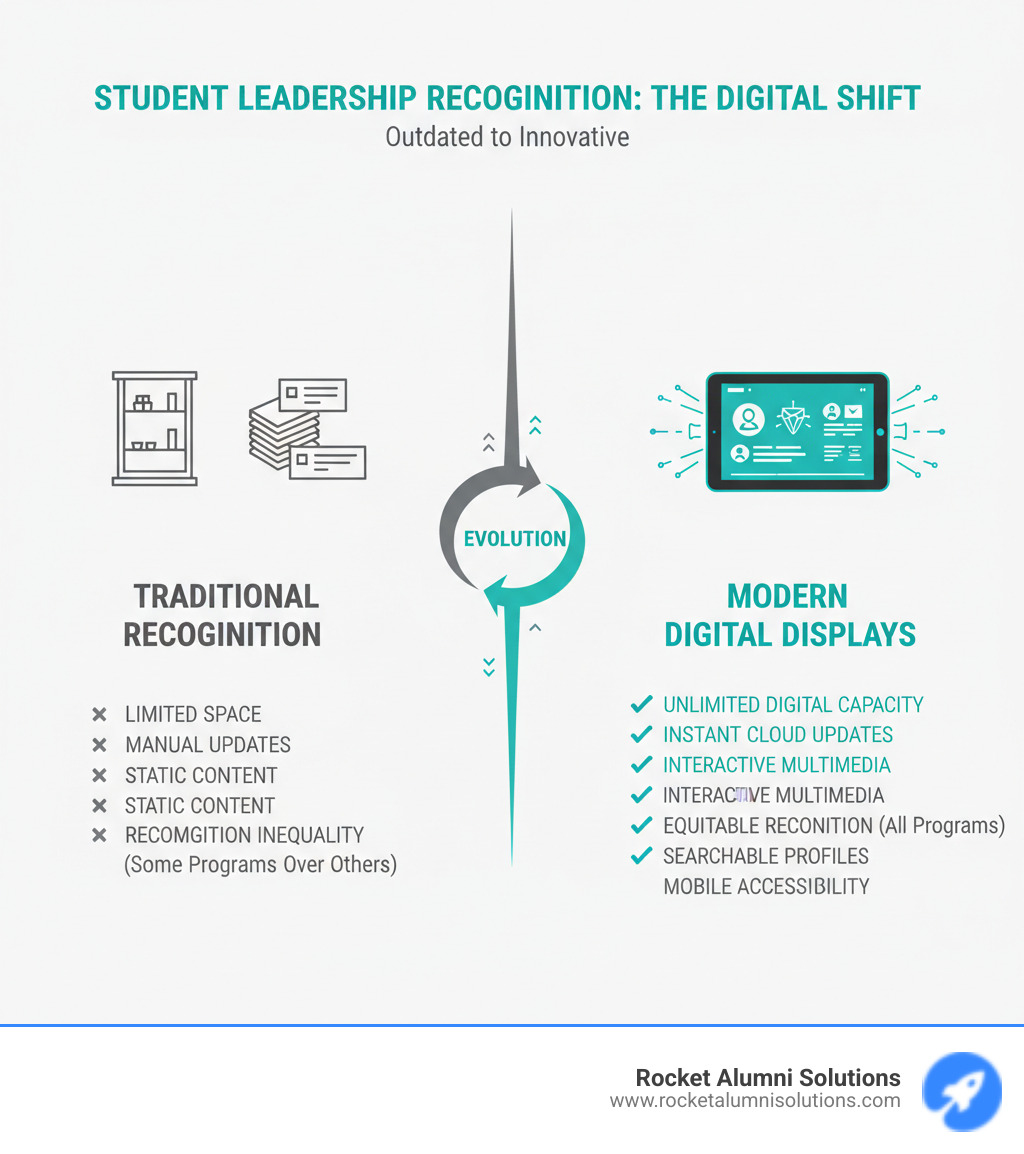
Quick Student Leadership Touchscreen terms:
What is a Student Leadership Touchscreen and Why Does it Matter?
Picture walking into your school's main entrance and seeing a vibrant, interactive display where students are gathered, pointing excitedly at their friend's profile, scrolling through championship moments, and finding achievements they never knew existed. That's the power of a Student Leadership Touchscreen—it transforms recognition from something you walk past into something you actively explore.
A Student Leadership Touchscreen is a dynamic digital hub that celebrates every form of student excellence in one centralized location. Unlike traditional trophy cases that gather dust or wall plaques that take months to produce, these interactive displays bring recognition to life through digital content that updates instantly and engages students in ways static displays never could.
The real challenge with traditional recognition isn't that schools don't care—it's that physical space creates impossible choices. When your football trophies fill the main case while debate champions, theater stars, and community service leaders go unrecognized simply because there's no room left, you're not building the inclusive culture you want. A single 55-inch touchscreen can showcase thousands of achievements that would require dozens of trophy cases and hundreds of feet of wall space. Suddenly, space limitations disappear entirely.
But here's what makes these systems truly matter: they fundamentally change how students engage with recognition. A 2019 study from the National Academy of Sciences found that active learning tools dramatically increased student engagement and information retention compared to passive viewing. The same principle applies to recognition. When students can search for their friends' achievements, explore multimedia content, and interact with their school's history, they become invested in ways that walking past a trophy case never accomplished.
The shift from passive viewing to active exploration creates genuine connection. Students don't just see that someone won an award—they can watch performance videos, view photo galleries, read about the journey behind the achievement, and find accomplishments they never knew their peers had earned. This deeper engagement builds the sense of community that every school strives to create.
Defining the Modern Student Leadership Touchscreen
So what exactly makes a modern Student Leadership Touchscreen system different from simply mounting a TV on the wall? It's about the technology working together to create an experience that feels effortless.
The foundation is unlimited digital capacity. You'll never face the heartbreaking decision of removing one student's plaque to make room for another. Every achievement finds a permanent home in your digital system, whether you're recognizing ten students or ten thousand. This matters enormously for equity—when space isn't a constraint, every program gets the recognition it deserves.
Behind the scenes, a cloud-based content management system powers everything. This means you can update content from anywhere, anytime—no need to be physically at the display with a screwdriver and new nameplate. When a student earns an honor, you can celebrate it immediately, not months later when the engraving finally arrives. Your staff saves countless hours previously spent managing physical displays.
The student experience centers on intuitive interactive navigation. Students can browse by program, search for specific people, filter by year or achievement type, and explore historical accomplishments with simple touches. It feels natural—like using their phone or tablet—which means they actually use it.
What makes the content truly findable is the searchable database underneath. Want to see every student who earned All-State honors in the last decade? Every member of championship teams? All the Presidential Service Award recipients? The search functionality turns your recognition system into a living archive of school excellence.
And we're beyond static displays in every sense. Modern systems integrate photos, videos, interactive timelines, and rich multimedia that tell the complete story behind each achievement. Instead of a name and date on a plaque, students see their peers' actual performances, project showcases, and the moments that made the accomplishment special.
Here's how traditional recognition stacks up against modern touchscreen systems:
| Feature | Traditional Recognition | Student Leadership Touchscreen |
|---|
| Capacity | Limited by physical space, finite | Unlimited digital capacity |
| Updates | Slow, manual, expensive (engraving, new plaques) | Instant cloud-based updates |
| Engagement | Passive viewing, static content | Active exploration, interactive multimedia |
| Equity | Often favors high-profile programs | Equal prominence for all achievements |
The difference isn't just technological—it's about creating a recognition system that actually serves every student, not just those in the most visible programs.
The Primary Benefits for Educational Institutions
When schools implement a Student Leadership Touchscreen, the benefits ripple through the entire community in ways that surprise even the biggest advocates.
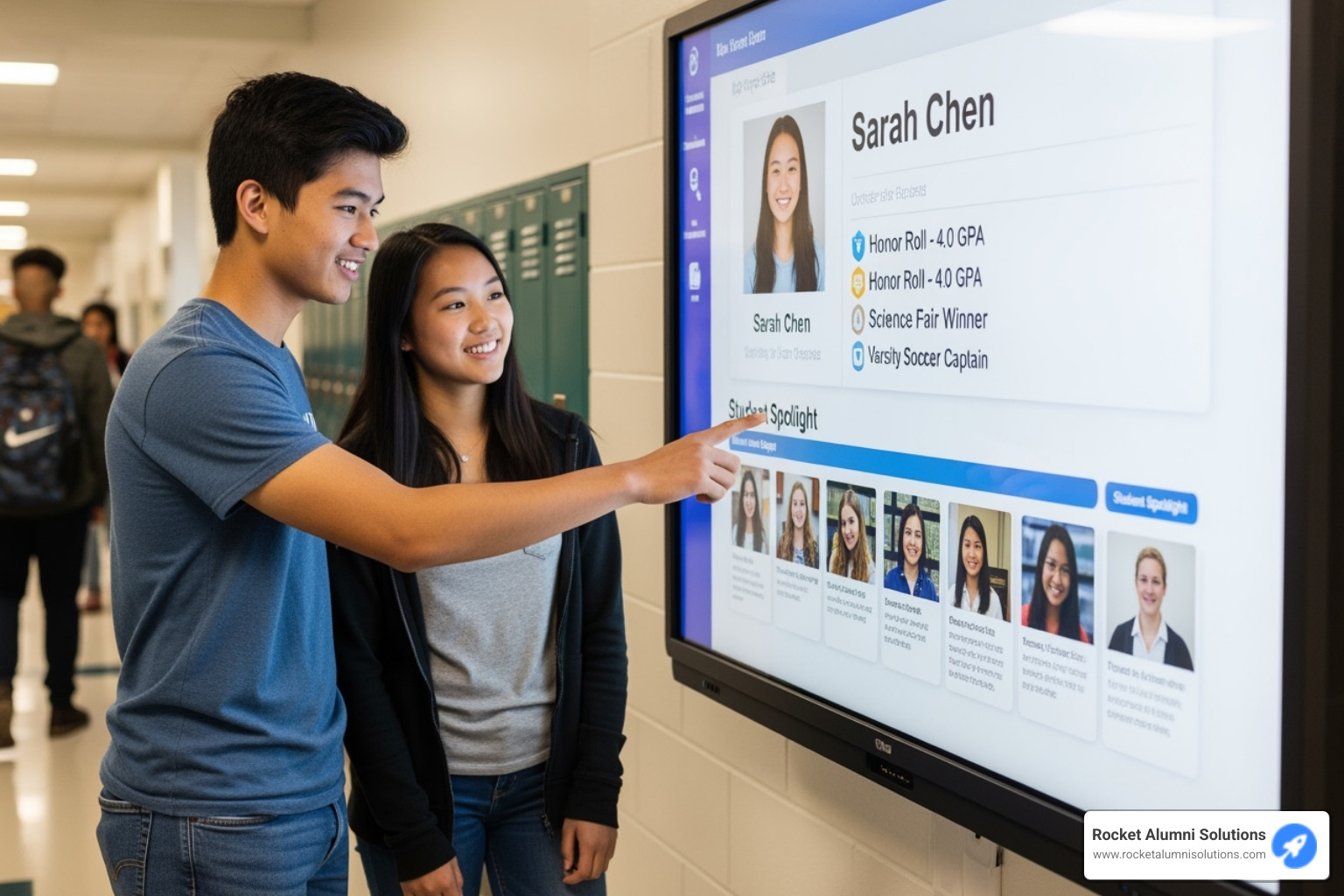
The most powerful impact is equitable recognition across all programs. Traditional trophy cases create unintended hierarchies—football gets the main entrance, while orchestra all-state selections end up in a hallway nobody walks down. Digital systems eliminate this entirely. Every achievement, whether in athletics, academics, fine arts, or community service, receives equal prominence and celebration. The data speaks clearly: students in schools with equitable recognition systems report 38% higher satisfaction with school culture and 29% greater sense of belonging. When students feel their accomplishments truly matter to their school, everything changes.
This equity drives increased student motivation and engagement in tangible ways. Students see themselves reflected in their school's recognition system. They see peers celebrated for all forms of excellence, not just the most visible ones. The interactive nature means students actively explore achievements rather than passively walking past them. This engagement creates a positive feedback loop—recognition inspires achievement, which leads to more recognition, building momentum across your entire student body.
The cultural shift runs deep. A comprehensive Student Leadership Touchscreen system fundamentally improves school culture by reinforcing that your school values all contributions. When a student who volunteers hundreds of community service hours receives the same prominent recognition as the star quarterback, you're living your values, not just stating them. This visible commitment to celebrating every form of student success creates the positive, supportive environment where all students thrive.
Prospective families notice immediately. An impressive Student Leadership Touchscreen in your lobby makes a powerful first impression that improves recruitment and community engagement. It demonstrates your school's commitment to student development and shows—not just tells—the breadth of opportunities and success your community creates. Alumni and community members engage with your school's legacy in new ways, strengthening connections that support your institution for years to come. Our School Achievement Recognition Programs | Complete Guide 2025 explores how recognition drives these deeper community connections.
Finally, let's talk about long-term cost-effectiveness. Yes, there's an initial investment, typically ranging from $8,000-$20,000 per display. But consider what you're replacing: endless trophy cases that cost thousands each, new plaques running $50-$200 apiece, engraving fees, maintenance, and the staff time managing it all. Digital updates take minutes instead of months and cost nothing after your initial setup. Over five to ten years, schools typically save significant money while dramatically improving their recognition capabilities. It's an investment that pays dividends financially and culturally.
At Rocket Alumni Solutions, we've seen these benefits transform schools firsthand. Our partner schools experienced over 25% increases in community engagement when they made recognition interactive and equitable. When every student's story matters and receives celebration, you're not just recognizing achievement—you're building the culture that creates it.
Showcasing Diverse Achievements with a Student Leadership Touchscreen
Every student brings something unique to your school community. The athlete who dedicates hours to practice. The artist who creates stunning portfolios. The volunteer who quietly changes lives. The student government officer who fights for better lunch options. They all deserve recognition—and a Student Leadership Touchscreen makes sure they get it.
Traditional trophy cases force schools into impossible choices. When space runs out, someone's achievement gets left behind. Often it's the quieter accomplishments—the community service hours, the art show selections, the peer mentoring—that disappear first. This creates real consequences: students in programs receiving less visible recognition report 42% lower satisfaction with school culture around achievement celebration.
A Student Leadership Touchscreen breaks down these achievement silos entirely. By offering unlimited digital space, it lets schools celebrate holistic recognition—valuing all forms of excellence equally. When students see their school honoring diverse talents and contributions, they develop a stronger sense of belonging. They understand that success isn't one-size-fits-all.
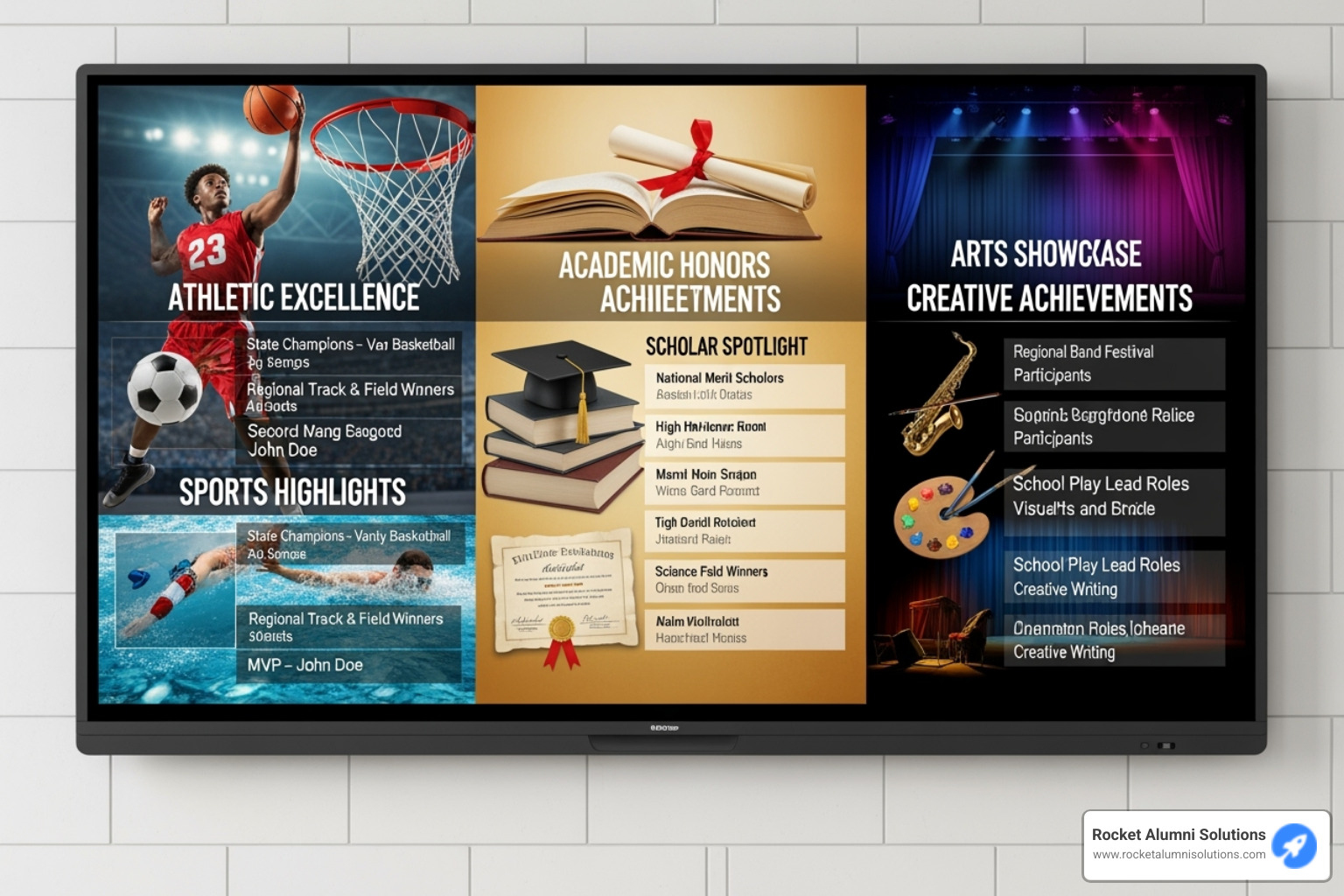
Recognizing Leadership and Community Service
Leadership doesn't always come with a title or a trophy. Sometimes it's the senior who tutors struggling freshmen every Tuesday afternoon. The student who organizes coat drives. The peer mediator who helps resolve conflicts before they escalate.
These contributions matter enormously, but they rarely get the recognition they deserve. A Student Leadership Touchscreen changes that by creating dedicated space for showcasing student government officers and their initiatives, club presidents who build thriving organizations, and peer mentors who strengthen your school community from within.
Community service particularly benefits from digital recognition. You can display volunteer hours with running totals, feature photo galleries from service projects, and celebrate students who've earned Presidential Service Awards or school citizenship awards. When a student reaches 100 volunteer hours, their profile can include testimonials from the organizations they've helped and photos of them in action.
Project showcases bring these achievements to life. Instead of just listing that someone "did community service," you can show the community garden they built, the fundraiser they organized, or the after-school program they created. This inspires other students to step up and lead in their own way.
Celebrating Academic and Fine Arts Excellence
Walk into most schools and you'll see athletic trophies prominently displayed. Academic and fine arts achievements? Often relegated to a bulletin board in a back hallway. This sends an unintended message about which accomplishments really matter.
Digital recognition creates equity. Your honor roll students can receive the same prominent placement as your championship teams. National Merit Scholars and AP Scholars get profiles that showcase their academic journey, not just their final scores. Students who achieve excellence on standardized tests, earn subject-specific academic awards, or win STEM competitions all find space on your Student Leadership Touchscreen.
For schools looking to create comprehensive academic recognition, our Academic achievement displays guide offers detailed strategies for celebrating intellectual excellence.
Fine arts achievements bring special opportunities for multimedia recognition. When a student makes all-state orchestra, you can include a video clip of their performance. Theater productions can feature cast photos, behind-the-scenes footage, and highlights from opening night. Visual arts students can have virtual gallery spaces displaying their portfolios, complete with artist statements explaining their creative process.
This approach transforms recognition from a simple list of names into rich storytelling. Students don't just see that someone won an art award—they see the actual artwork. They don't just read that someone made all-state choir—they hear them sing. This creates deeper engagement and shows students that their school genuinely values these accomplishments.
Ensuring Equitable Recognition Across All Programs
Creating truly equitable recognition requires more than just digital space—it demands intentional design and ongoing attention. The goal isn't just showcasing everything, but showcasing everything fairly.
Start with transparent achievement policies. When students understand exactly what qualifies for recognition across all programs, they trust the system. A student earning her black belt should know she'll receive the same consideration as the student who makes varsity basketball. Clear criteria eliminate guesswork and perceived favoritism.
Student-led nomination processes add another layer of equity. Students often notice achievements that adults miss—the classmate who's always helping others, the peer who showed remarkable perseverance, the student who turned their grades around through sheer determination. Empowering students to nominate their peers creates a recognition system that captures the full picture of excellence in your school.
Rotating content features ensure that different programs receive prime visibility throughout the year. Your main display might highlight fall sports achievements in October, theater productions in November, and community service projects in December. This rotation prevents any single program from dominating the conversation while keeping content fresh and engaging.
The most meaningful recognition often comes from celebrating what we call unsung heroes. These are students who might never win a championship or earn a perfect score, but who demonstrate remarkable growth, persistence, kindness, or improvement. A student who raised their GPA from 2.0 to 3.5 through dedicated effort deserves recognition just as much as the student who maintained a 4.0.
For more insights on creating comprehensive recognition systems, explore our guide on Digital recognition displays.
Finally, use data-driven equity audits to monitor how your recognition system performs in practice. Analytics from your touchscreen can reveal which types of achievements get the most engagement, which programs receive the most features, and whether certain student groups are underrepresented. This data helps you identify and address unintentional biases before they become patterns.
When students see their school actively working to ensure fair recognition across all programs, it reinforces a powerful message: every form of excellence matters here. Every student's contributions count. This creates the sense of belonging that transforms schools from buildings into communities.
Key Features and Practical Implementation
Bringing a Student Leadership Touchscreen to life is an exciting journey that starts with understanding both the technology and the practical steps needed to make it work in your school. From the moment you decide to accept digital recognition, you'll be thinking about hardware choices, software capabilities, content creation, and how everything fits together to create something truly special for your students.
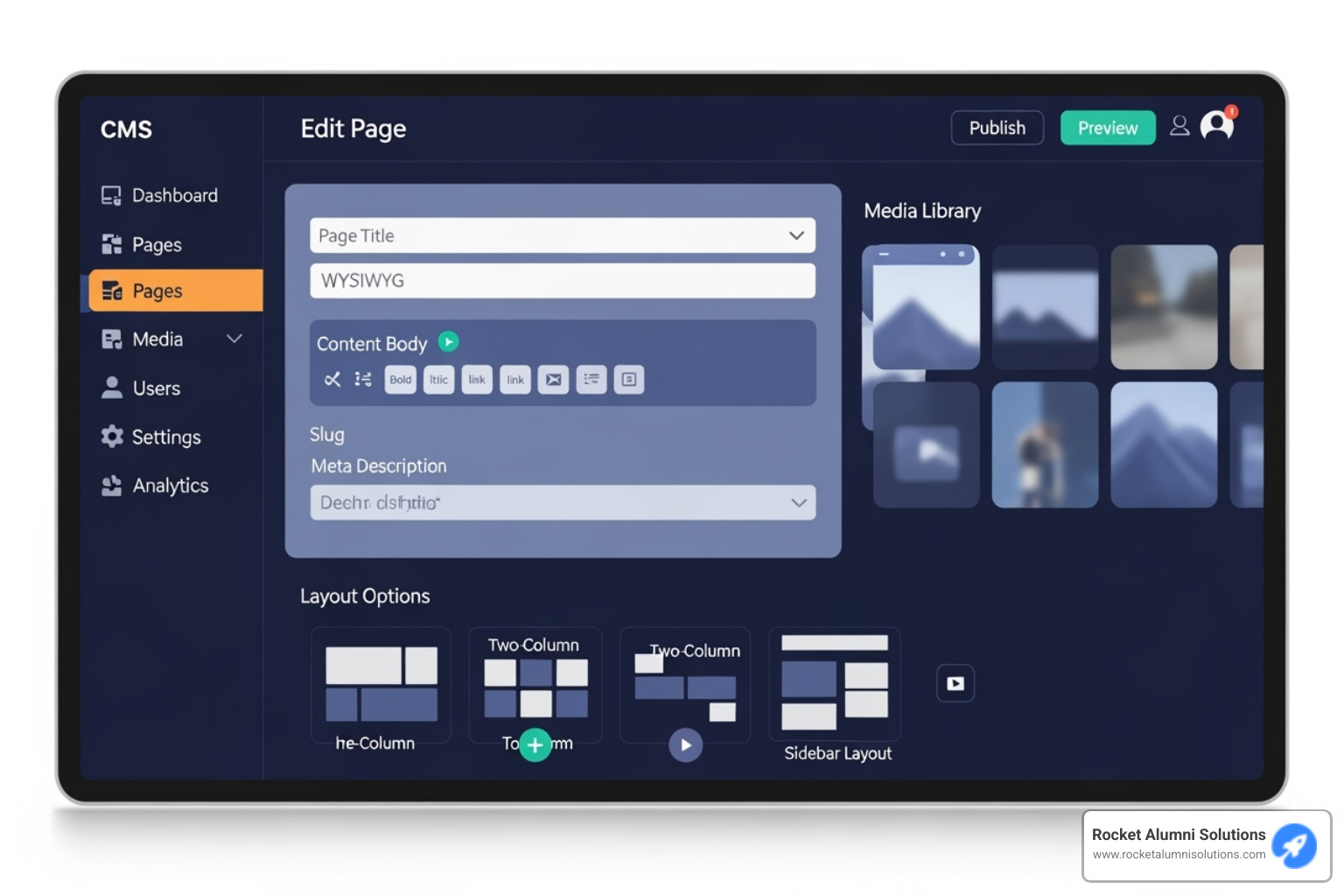
Essential Features of an Effective System
When you're selecting a Student Leadership Touchscreen system, certain features make all the difference between a display that just sits there and one that truly engages your community.
Commercial-grade hardware is your foundation. These aren't the televisions you'd buy for your living room—they're built to run continuously in busy public spaces. You need displays that can handle constant use, maintain brightness throughout the day, and stand up to countless student interactions. Look for tempered glass, robust construction, and displays rated for at least 50,000 hours of operation. That's years of reliable service celebrating your students' achievements.
The cloud-based software is what makes modern digital recognition truly transformative. With cloud technology, you can update content from your office, your classroom, or even your phone while waiting in the pickup line. No more climbing ladders to rearrange physical displays or waiting weeks for new plaques to arrive. When a student wins an award on Friday, it can be on the display by Monday morning.
Your system needs an intuitive user interface that makes sense to everyone who walks up to it. Grandparents visiting for a concert should be able to find their grandchild's achievements just as easily as tech-savvy students can. Clear categories, responsive touch controls, and simple navigation turn casual viewers into engaged explorers of your school's success stories.
Robust search and filtering capabilities let people find exactly what they're looking for. Students want to find their friends' accomplishments. Alumni visiting the school want to see how their old records compare. Parents want to track their child's growing list of achievements. A powerful search function makes all of this possible with just a few taps.
Multimedia support brings achievements to life in ways static displays never could. High-resolution photos capture the emotion of championship moments. Videos showcase theater performances, musical recitals, and award ceremonies. Animated elements add visual interest and draw people in. This rich media transforms recognition from a simple list of names into compelling stories of student success.
For your IT staff, remote management capabilities are invaluable. The ability to monitor, troubleshoot, and update displays from anywhere saves countless hours and ensures consistent performance across multiple installations. When you're managing recognition for an entire district, this efficiency becomes essential.
Analytics and reporting features provide insights you've never had before. Which achievements get the most views? When do people interact with the display most frequently? What content keeps visitors engaged longest? This data helps you refine your recognition strategy and ensure you're highlighting the achievements that matter most to your community. Our touchscreen kiosk software and hardware guide explores these technical capabilities in depth.
Practical Considerations for Your Student Leadership Touchscreen
Successfully implementing a Student Leadership Touchscreen requires thoughtful planning, but it doesn't have to be overwhelming. We've helped schools through this process many times, and we can guide you through each step.
Start with a needs assessment that honestly evaluates your current recognition methods. Walk through your hallways and ask yourself: Which achievements are prominently displayed? Which ones are tucked away or not shown at all? Who feels celebrated, and who might feel overlooked? What specific goals do you have for your new system? These answers shape everything that follows.
Budgeting comes next, and it's important to think beyond just the initial purchase. Yes, there's an upfront investment in hardware and software—typically between $8,000 and $20,000 per display depending on size and features. But also consider the ongoing costs like software licensing, content management time, and occasional maintenance. The good news? These long-term costs are often lower than the recurring expenses of traditional trophy cases, plaques, and engraving.
Hardware selection depends on where you'll place the display and how you want it to look. A 55-inch touchscreen works beautifully in a lobby where people can gather around it. A larger video wall makes a stunning statement in a main entrance. Consider viewing distance, available space, and your school's aesthetic. Make sure mounting options meet ADA compliance requirements so everyone can interact with the display comfortably.
Content development workflow is where your recognition strategy comes to life. You'll need to gather historical achievement data, collect photos and videos, and organize everything in a way that makes sense. This might involve digging through old yearbooks, reaching out to coaches and club advisors, and even recruiting students to help document current achievements. Creating a clear workflow for adding new content ensures the system stays current and relevant.
Staff training doesn't need to be complicated, but it's essential. Key staff members—maybe an activities director, athletic director, and communications coordinator—should feel confident using the content management system. They need to know how to upload new achievements, update student profiles, and handle basic troubleshooting. Most systems are designed to be user-friendly, so training typically takes just a few hours.
Ongoing maintenance keeps everything running smoothly for years. Commercial-grade hardware is built to last, but having a plan for routine software updates, content audits, and occasional hardware checks ensures your investment continues delivering value. Many schools involve student technology clubs in this maintenance, turning it into a leadership opportunity.
Integrating with Existing School Technologies
Your Student Leadership Touchscreen shouldn't be an island—it should connect seamlessly with the digital tools you already use. This integration makes your life easier and your recognition more comprehensive.
Student Information Systems (SIS) integration can automate much of your academic recognition. Through API connections, honor roll lists, scholarship recipients, and academic distinctions can flow directly from your SIS to your touchscreen display. No more manual data entry, no more worrying about typos or outdated information. When grades are finalized, achievements are automatically updated.
Athletic management platforms work the same way for sports achievements. Game scores, record-breaking performances, and championship results can automatically populate your display. Your athletic director doesn't need to duplicate work—the information flows from the tools they're already using.
Social media integration extends your recognition beyond the school walls. Configure your system to automatically share new achievements to your school's Facebook, Twitter, or Instagram accounts. Suddenly, that student's accomplishment isn't just celebrated by people walking past the display—it's shared with your entire community, including alumni across the country.
School websites and communication tools benefit from this connectivity too. Embed web-based versions of your digital recognition displays on your school website. Include achievement highlights in weekly newsletters. Make it easy for remote families and community members to celebrate student success, no matter where they are.
The API integration capabilities that power all of these connections create a truly unified campus recognition network. Information flows where it needs to go, staff time is spent celebrating students rather than duplicating data entry, and nothing falls through the cracks. It's recognition that works as hard as your students do.
At Rocket Alumni Solutions, we've designed our systems with these integrations in mind. We know you're already juggling multiple platforms and tools, and we want to make your recognition efforts easier, not more complicated. When technology works together, everyone wins—especially the students you're celebrating.
The Long-Term Impact and Future of Recognition
When we think about investing in a Student Leadership Touchscreen, we're not just buying a piece of technology. We're making a strategic investment in our school's culture that will pay dividends for years to come. The real question isn't whether we can afford to implement this system—it's whether we can afford not to.
Let's talk numbers for a moment. Traditional recognition has hidden costs that add up quickly. A single engraved plaque runs $100-$300, and when we need another trophy case, we're looking at $2,000-$5,000 per addition. Meanwhile, a digital Student Leadership Touchscreen system typically requires an initial investment of $8,000-$20,000 per display, with annual software licensing fees ranging from $1,500-$5,000. Yes, the upfront cost is higher. But here's what makes it smart: we get unlimited capacity, instant updates, and no more ordering plaques or expanding physical display space. Over five to ten years, the digital system often becomes the more economical choice. It's the classic "pay more upfront, save more long-term" scenario that financial planners love.
But the return on investment goes far beyond dollars and cents. A consistently updated, equitable recognition system becomes the heartbeat of our school culture. It creates a living history that inspires current students by showcasing the legacy of those who came before them. Every time a freshman sees a senior's achievements displayed, or a student finds an alumnus who walked similar halls decades ago, we're reinforcing the values that define our community.
Our alumni feel this connection deeply. They love seeing their names and accomplishments preserved and celebrated in ways that static plaques simply can't match. When recognition displays are accessible online—something our systems at Rocket Alumni Solutions make possible—former students can reconnect with their alma mater from anywhere in the world. They can show their children or grandchildren their own achievements, see how their records have stood the test of time, or find current students following in their footsteps. This fosters a deeper sense of pride and encourages ongoing support, whether through mentorship, donations, or community involvement.
There's also the reputation factor. When prospective families tour our school and see a modern, interactive display celebrating diverse achievements, it sends a powerful message. We're forward-thinking. We value every form of excellence. We invest in our students' success. That first impression matters more than we might think in today's competitive educational landscape.
The future of recognition technology is genuinely exciting, and our future trends in digital recognition guide explores these possibilities in depth. Artificial intelligence is already beginning to revolutionize how we capture and display achievements. Imagine a system that automatically populates student profiles based on academic records or athletic results, making recognition nearly instantaneous. No more waiting for someone to manually enter data—the system does the heavy lifting.
Personalized experiences are another frontier we're approaching. Future systems could allow students to log in and see a customized collection of their own achievements, or filter the display to focus on specific programs or friends. This transforms the touchscreen from a general recognition tool into something deeply personal for each viewer.
Augmented reality integration might sound like science fiction, but it's closer than we think. Imagine pointing your phone at a championship team photo and seeing a 360-degree virtual tour of that historic game, or watching highlight reels overlay directly onto the display. These immersive experiences will make recognition even more engaging and memorable.
The analytics capabilities are also evolving rapidly. More sophisticated data tracking will help us understand achievement patterns, identify program trends, and even explore correlations between visible recognition and student motivation. This "achievement science" will help schools refine their recognition strategies based on real evidence, not just intuition.
At Rocket Alumni Solutions, we're committed to staying at the forefront of these developments. Our Student Leadership Touchscreen systems aren't static products—they evolve with technology, ensuring that our partner schools always have access to the most effective recognition tools available. Because ultimately, this isn't about the technology itself. It's about creating environments where every student feels seen, valued, and inspired to achieve their personal best.
Frequently Asked Questions about Student Leadership Touchscreens
Let's talk about the questions we hear most often when schools are considering a Student Leadership Touchscreen system. These are the practical, real-world concerns that matter when making this decision for your community.
What is the total cost of implementing an achievement touchscreen system?
The honest answer is that your first-year investment typically ranges from $8,000 to $20,000 per display. This covers the commercial-grade hardware you need for continuous operation, your initial software licensing fees, and professional installation to get everything running smoothly.
I know that number might make you pause. But here's what we've learned from working with schools across the country: when you compare this to traditional methods over time, the math actually works in favor of digital systems.
Think about it this way. Every new plaque costs between $100 and $300. Adding another trophy case? That's $2,000 to $5,000 each time you run out of space. And you will run out of space. These costs never stop. With a digital system, after that initial investment, you're primarily looking at annual software licensing fees of $1,500 to $5,000. No more ordering plaques. No more building new cases. No more choosing whose achievements to remove to make room for new ones.
The long-term ROI becomes clear pretty quickly. You get unlimited capacity, instant updates, and a system that keeps getting better rather than more expensive to maintain.
How much staff time does content management require?
This question matters because nobody has extra time in their day. The good news? Our cloud-based systems are designed to make content management surprisingly manageable.
The initial content loading is where you'll invest the most time—typically 40 to 100 hours depending on how much historical data you want to include. This is when you're digitizing past achievements, gathering photos, and building that foundation. It's a one-time effort, and many schools turn it into a student project or spread it across a summer when schedules are lighter.
Once that foundation is set, ongoing updates are quick. Adding new achievements typically takes just 15 to 30 minutes per entry. Compare that to coordinating with engravers, waiting for plaques to arrive, and physically installing them—the time savings are significant.
And here's something we really encourage: get students involved in content creation. Yearbook staff, student government members, or class historians often love taking ownership of keeping recognition current. It's a valuable learning opportunity that also lightens the load on busy administrators. With our intuitive interface and workflow automation features, even student volunteers can manage updates easily. When you integrate with systems like your Student Information System, some data entry happens automatically.
The bottom line is that digital recognition saves staff time compared to traditional methods, not the other way around.
Will students actually use an interactive touchscreen for recognition?
This is the question that determines whether the investment truly pays off, and we're thrilled to say the answer is a resounding yes—when it's done right.
Students engage with Student Leadership Touchscreens because the experience is personally meaningful. They're not just walking past a static display. They're actively searching for their own achievements, finding their friends' recognition, and exploring programs they care about. That personal relevance makes all the difference.
We've watched students crowd around displays during lunch periods, pointing out their teammates' accomplishments and sharing their excitement about being featured. The ability to quickly find and show others your achievement creates these spontaneous moments of celebration that traditional plaques simply can't generate.
The interactive elements matter too. When you can tap through photo galleries, watch performance videos, or explore interactive timelines, the display becomes an experience rather than just information. It's the difference between reading about a championship and actually seeing the game-winning moment captured on video.
Strategic placement amplifies all of this. When you position your Student Leadership Touchscreen in high-traffic areas—main lobbies, cafeteria entrances, athletic facilities, or student centers—you create multiple daily opportunities for engagement. Students interact with it while waiting for rides, during passing periods, or when showing visiting family members around campus.
The data backs this up too. Schools with equitable digital recognition systems report 38% higher student satisfaction with school culture. That's not just because the technology is cool—it's because students feel genuinely seen and valued when their achievements are celebrated in engaging, accessible ways.
At Rocket Alumni Solutions, we've seen how the right recognition system transforms school culture. Our partner schools experienced over 25% increases in community engagement when they made every student's story visible and interactive. That's the power of making recognition personal, equitable, and engaging through modern interactive touchscreen software solutions.
Conclusion
We've come a long way from those dusty trophy cases and static wall plaques gathering fingerprints in the hallway. Throughout this guide, we've explored how Student Leadership Touchscreen systems are changing the way schools celebrate student success—offering unlimited digital capacity, instant cloud-based updates, and interactive multimedia experiences that bring achievements to life in ways traditional displays never could.
The benefits speak for themselves. When students see their accomplishments recognized equitably—whether they're scoring the winning goal, earning academic honors, performing in the school musical, or volunteering countless hours in their community—they feel valued. That sense of belonging translates into real results: 38% higher satisfaction with school culture and 29% greater sense of belonging in schools that recognize achievement across all programs fairly.
But this isn't just about the numbers. It's about the student who finally sees their robotics team championship celebrated with the same prominence as the football team. It's about the theater student whose performance video inspires a younger classmate to audition. It's about building a school culture where every form of excellence matters, where every student can find themselves reflected in their school's story.
By choosing a Student Leadership Touchscreen system, you're making a statement about what your school values. You're saying that every achievement deserves recognition, that every student matters, and that your institution is committed to celebrating success in all its diverse forms. You're empowering student leaders to shine while building a lasting culture of excellence that will inspire current students and connect alumni for years to come.
At Rocket Alumni Solutions, we've dedicated ourselves to helping schools like yours transform how they recognize and celebrate student achievement. We've seen how our partner schools experienced over 25% increases in community engagement when they lifted every contributor's story through our interactive touchscreen software. We believe every student is an all-star in their own way, and we're passionate about giving schools the tools to show it.
Ready to bring this change to your school? Explore interactive touchscreen software solutions and find how we can help you create a recognition system that truly honors every student's success while building the culture of excellence your school deserves.


















































































































